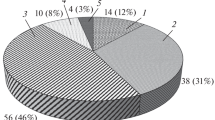Abstract
In order to improve the efficiency of a geothermal power plant, oil wells in the high water cut stage were used as geothermal wells, thereby improving the recovery ratio and economic benefit. A new function that reflects both the technical and economic performances was put forward and used as the objective function. An organic Rankine cycle (ORC) was analyzed through the energetic and exergetic analyses, and the reasons for low efficiency were pinpointed. Results indicate that geothermal water directly transferring heat to the working fluid reduces energy dissipation and increases cycle efficiencies. The net power output with an internal heat exchanger (IHE) is averagely 5.3% higher than that without an IHE. R601a and R601 can be used to replace R123 for geothermal water below 110 °C. Moreover, the modified ORC dramatically outperforms the actual one.
Similar content being viewed by others
References
National Bureau of Statistics of China. China statistical abstract 2010 [R]. Beijing: China Statistics Press, 2010. (in Chinese)
BARBIER E. Geothermal energy technology and current status: An overview [J]. Renewable and Sustainable Energy Review, 2002, 6(1/2): 3–65.
DRESCHER U. Optimierungspotenzial des Organic Rankine Cycle für geothermische und biomassebefeuerte Wärmequellen [D]. Berlin: University Bayreuth, 2008. (in Chinese)
HAN Gang. Study on computational method of the water flooded layer aqueous saturation in high water cut stage [D]. Daqing: Daqing Petroleum Institute, 2008. (in Chinese)
TIAN Yu-jiang. Technical research of using geothermal water for heat tracing system in gathering system of oil field [D]. Dongying: China University of Petroleum, 2009. (in Chinese)
HETTIARACHCHI H D M, GOLUBOVIC M, WOREK W M, IKEGAMI Y. Optimum design criteria for an organic Rankine cycle using low-temperature geothermal heat sources [J]. Energy, 2007, 32(9): 1698–1706.
BORSUKIEWICZ-GOZDUR A, NOWAK W. Maximising the working fluid flow as a way of increasing power output of geothermal power plant [J]. Applied Thermal Engineering, 2007, 27: 2074–2078.
HEBERLE F, BRÜGGEMANN D. Exergy based fluid selection for a geothermal organic Rankine cycle for combined heat and power generation [J]. Applied Thermal Engineering, 2010, 30(11/12): 1326–1332.
SALEH B, KOGLBAUER G, WENDLAND M, FISCHER J. Working fluids for low temperature organic Rankine cycles [J]. Energy, 2007, 32(7): 1210–1221.
DESAI N B, BANDYOPADHYAY S. Process integration of organic Rankine cycle [J]. Energy, 2009, 34(10): 1674–1686.
KANOGLU M, BOLATTTURK A. Performance and parametric investigation of a binary geothermal power plant by exergy [J]. Renewable Energy, 2008, 33(11): 2366–2374.
YARI M. Exergetic analysis of various types geothermal power plants [J]. Renewable Energy, 2010, 35(1): 112–121.
YARI M. Performance analysis of the different organic Rankine cycles (ORCs) using dry fluids [J]. International Journal of Exergy, 2009, 6(3): 23–42.
GUO T, WANG H X, ZHANG S J. Comparative analysis of natural and conventional working fluids for use in transcritical Rankine cycle using low-temperature geothermal source [J]. International Journal of Energy Research, 2011, 35(6): 530–544.
HUA Jun-ye, CHEN Ya-ping, LIU Hua-jin, WU Jia-feng. Thermodynamic analysis of simplified dual-pressure ammonia-water absorption power cycle [J]. Journal of Central South University, 2012, 19(3): 797–802.
WANG Zhi-qi, ZHOU Nai-jun, LUO Liang, ZHANG Jia-qi, TONG Dao-hui. Comparison of thermodynamic performance for waste heat power generation system with different low temperature working fluids [J]. Journal of Central South University: Science and Technology,, 2010, 41(6): 2424–2429. (in Chinese)
WANG Zhi-qi, ZHOU Nai-jun, GUO Jing, WANG Xiao-yuan. Parametric optimization of low-temperature waste heat power generation system by simulated annealing algorithm [J]. Journal of Central South University: Science and Technology, 2012, 43(1): 366–371. (in Chinese)
MARTIN H. A theoretical approach to predict the performance of chevron-type plate heat exchangers [J]. Chemical Engineering and Processing, 1996, 35(4): 301–310.
KHAN T S, KHAN M S, CHYU M C, AYUB Z H. Experimental investigation of single phase convective heat transfer coefficient in a corrugated plate heat exchanger for multiple plate configurations [J]. Applied Thermal Engineering, 2010, 30(8/9): 1058–1065.
COOPER M G. Heat flows rates in saturated pool boiling: A wide ranging examination using reduced properties, advances in heat transfer [M]. Florida: Academic Press, 1984.
PALM B, CLAESSON J. Plate heat exchanger: calculation methods for single and two-phase flow [J]. Heat Transfer Engineering, 2006, 27(4): 88–98.
DIPIPPO R. Second Law assessment of binary plants generating power from low temperature geothermal fluids [J]. Geothermics, 2004, 33(4): 565–586.
ARSLAN O, KOSE R. Exergoeconomic optimization of integrated geothermal system in Simav, Kutahya [J]. Energy Conversion and Management, 2010, 51(4): 663–676.
WANG Jiang-feng, DAI Yi-ping, GAO Lin. Exergy analyses and parametric optimizations for different cogeneration power plants in cement industry [J]. Applied Energy, 2009, 86(6): 941–948
KANOGLU M. Exergy analysis of a dual-level binary geothermal power plant [J]. Geothermics, 2002, 31(6): 709–724
de VRIES B, TILLNER-ROTH R, BAEHR H D. Thermodynamic properties of HCFC 124 [C]// Nineteenth international congress of refrigeration. The Hague: International Institution of Refrigeration, 1995: 582–589.
MIYAMOTO H, WATANABE K. A thermodynamic property model for fluid-phase isobutene [J]. International Journal of Thermophysics, 2002, 23(2): 477–499.
PLATZER B, POLT A, MAURER G. Thermophysical properties of refrigerants [M]. Berlin: Springer-Verlag, 1990.
CALM J M, HOURAHAN GC. Refrigerant data update [J]. Heating/Piping/Air Conditioning Engineering, 2007, 79(1): 50–64.
MIYAMOTO H, WATANABE K. Thermodynamic property model for fluid-phase n-butane [J]. International Journal of Thermophysics, 2001, 22(2): 459–475.
Author information
Authors and Affiliations
Corresponding author
Additional information
Foundation item: Project(2012AA052804) supported by the National High Technology Research and Development Program of China
Rights and permissions
About this article
Cite this article
Li, Tl., Zhu, Jl. & Zhang, W. Performance analysis and improvement of geothermal binary cycle power plant in oilfield. J. Cent. South Univ. 20, 457–465 (2013). https://doi.org/10.1007/s11771-013-1507-x
Received:
Accepted:
Published:
Issue Date:
DOI: https://doi.org/10.1007/s11771-013-1507-x




